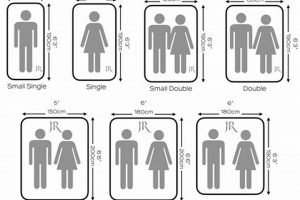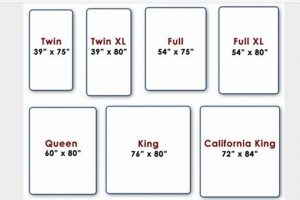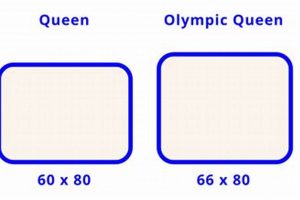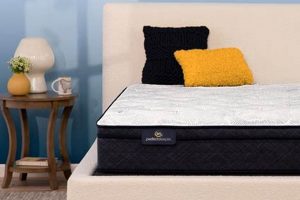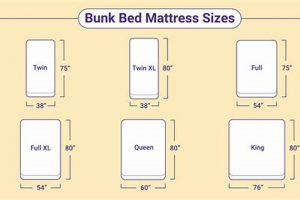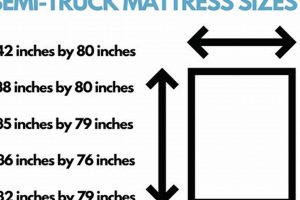The dimensions of a mattress intended for a bunk bed are a crucial consideration for safety and comfort. These mattresses are generally thinner than standard mattresses to ensure adequate safety railing height and prevent accidental falls. A typical measurement for these mattresses is around 39 inches wide and 75 inches long, corresponding to a twin size, with a thickness often limited to between 5 and 8 inches. For example, if a bunk bed has a maximum mattress height allowance of 6 inches, exceeding that could compromise the safety features.
Proper mattress dimensions for bunk beds are essential for preventing injuries and ensuring a comfortable sleep experience. Historically, issues related to unsuitable mattress sizes have led to safety standards and regulations focused on bunk bed construction and accessory usage. The use of appropriate dimensions can greatly improve the structural integrity and usability of the bed, allowing for long-term use and user satisfaction.
This discussion necessitates a deeper examination of the various factors involved in selecting a mattress for bunk beds, including safety regulations, material considerations, comfort levels, and long-term durability. Each of these elements play a critical role in the overall performance and safety of the sleep system.
Essential Guidance for Bunk Bed Mattress Selection
Selecting a suitable mattress for a bunk bed demands careful consideration of safety regulations and practical constraints. The following guidelines are designed to assist in making an informed decision.
Tip 1: Adhere to Height Restrictions: Always observe the maximum mattress height specified by the bunk bed manufacturer. Exceeding this limit reduces the effectiveness of the safety rails, increasing the risk of falls. Verify the interior depth of the guardrail to ensure that sufficient protection remains after the mattress is installed.
Tip 2: Prioritize Safety Standards: Ensure that the chosen mattress meets relevant safety standards and certifications. These certifications often indicate that the mattress has undergone testing for flammability, off-gassing, and other potential hazards. Compliance with standards helps to mitigate potential risks.
Tip 3: Confirm Dimensional Accuracy: Before purchasing, precisely measure the bunk bed frame’s inner dimensions to guarantee a proper fit. A mattress that is either too large or too small can create unsafe gaps or compromise the bed’s structural integrity. Accurate measurement avoids compatibility issues.
Tip 4: Evaluate Mattress Density: Consider the density of the mattress material. Denser mattresses provide better support and durability, which is especially crucial for bunk beds used by growing children or adults. Evaluate the weight capacity of both the mattress and the bunk bed frame to ensure compatibility.
Tip 5: Consider Mattress Material: Explore different mattress materials, such as memory foam, innerspring, or latex, based on comfort preferences and potential allergies. Ensure that the chosen material meets flammability standards without the use of harmful chemicals. Material choice significantly influences comfort and safety.
Tip 6: Review Warranty and Return Policies: Before finalizing the purchase, thoroughly review the mattress’s warranty and return policies. This safeguard allows for the return or replacement of the mattress if it does not meet expectations or is defective. Understanding the terms protects against potential dissatisfaction.
Choosing an appropriately sized and certified mattress for a bunk bed is paramount for ensuring the safety and well-being of its users. Prioritizing these considerations minimizes potential hazards and promotes a secure sleep environment.
Moving forward, it’s crucial to integrate this knowledge into the broader context of bunk bed safety and responsible product selection. The subsequent sections will explore related topics and provide further guidance.
1. Thickness Limitations
The thickness of a bunk bed mattress is a primary factor dictated by safety concerns and directly influences the overall “bunk mattress size.” Excessive thickness compromises the protective function of the guardrails, increasing the risk of falls, particularly from the upper bunk. Regulations and manufacturers’ guidelines specify maximum mattress thicknesses to maintain a safe guardrail height above the mattress surface. For example, if a bunk bed has a 5-inch guardrail clearance, a mattress exceeding 7 inches in thickness would diminish the effective height of the barrier, creating a potential hazard. The relationship between “bunk mattress size,” specifically its thickness, and the residual guardrail height is thus a critical safety consideration.
Implementing thickness limitations involves precise adherence to manufacturer recommendations and periodic monitoring. Over time, mattresses can compress, subtly altering their effective thickness and reducing guardrail clearance. Regular inspection and, if necessary, replacement of the mattress are essential to maintain optimal safety. Furthermore, the material composition of the mattress impacts its ability to retain its specified thickness over extended use. Higher-density materials generally exhibit less compression, contributing to greater long-term safety compliance. An inappropriately thick mattress, even if initially compliant, can become a hazard due to gradual compression.
In conclusion, “Thickness Limitations” are an indispensable component of the broader understanding of “bunk mattress size,” intrinsically linked to user safety. Understanding these limitations and adhering to manufacturer guidelines is crucial for preventing injuries associated with bunk bed use. Challenges arise in maintaining consistent compliance over time due to mattress compression and the variability in product standards; however, consistent vigilance and proper mattress selection can mitigate these concerns.
2. Width Consistency
Width consistency is a crucial element of bunk mattress size, directly influencing both safety and comfort. Deviation from standard width dimensions can compromise the structural integrity of the bed frame and present potential safety hazards to users.
- Standard Dimensions and Frame Compatibility
The standard width dimension for a twin-size bunk mattress is approximately 39 inches. Adherence to this dimension ensures compatibility with standard bunk bed frames designed to accommodate mattresses of this size. An inconsistent width can result in a mattress that either does not fit securely within the frame or requires excessive force to install, potentially damaging the frame or creating dangerous gaps.
- Impact on Guardrail Effectiveness
A mattress that is narrower than the designated width leaves gaps between the mattress edge and the guardrails. These gaps increase the risk of accidental falls, negating the primary safety function of the guardrails. Consistent width ensures that the guardrails provide a continuous barrier along the perimeter of the sleeping surface, minimizing the likelihood of incidents. Examples include a child rolling off the edge and falling through the gap or extremities becoming trapped.
- Structural Load Distribution
When the mattress width is inconsistent, the weight distribution on the bunk bed frame becomes uneven. This uneven distribution can lead to structural stress and premature wear on specific areas of the frame. A consistent width ensures that the load is distributed evenly across the support structure, enhancing the longevity and stability of the bunk bed. A common scenario is a bed slat breaking because the bunk mattress does not fully extend to support it from edge to edge.
- User Comfort and Sleep Quality
Beyond safety, consistent width contributes to user comfort. A mattress that is too narrow can create a feeling of insecurity and restrict movement during sleep, affecting sleep quality. The intended sleep surface should consistently fill the appropriate space, allowing freedom of movement. If the mattress is too small, the occupants will not be as comfortable as they should be.
In summary, maintaining width consistency in bunk mattresses is essential for frame compatibility, guardrail effectiveness, structural load distribution, and user comfort. Adherence to established dimensional standards is paramount for ensuring a safe and satisfactory bunk bed experience. These considerations all have a direct impact on bunk mattress size, leading to a safer product for everyone.
3. Length Standardization
Length standardization within “bunk mattress size” is critical for ensuring both safety and usability. The intended occupant’s height, combined with the bunk bed’s structural design, dictates the required mattress length. The standard length for a twin-size mattress, frequently used in bunk beds, is 75 inches. Deviations from this standardized length can lead to several issues. For example, a mattress shorter than the standardized length creates a gap, posing a potential entrapment hazard. Conversely, a mattress longer than specified might not fit within the bunk bed frame, compromising the structural integrity of the assembly. Therefore, adherence to length standardization is not merely a matter of convenience, but a vital safety measure.
The practical application of length standardization involves careful measurement and selection. Prior to purchasing a bunk mattress, the internal dimensions of the bunk bed frame must be precisely measured. This process ensures compatibility and eliminates the risks associated with improperly sized mattresses. Further, length standardization plays a significant role in manufacturing quality control. Manufacturers must adhere to strict dimensional tolerances to ensure that their mattresses meet the required standards. Inconsistent mattress lengths, resulting from manufacturing errors, can lead to consumer dissatisfaction and potential safety recalls. This underlines the operational impact that standardization in mattress sizing has, specifically in upholding bunk bed safety protocols.
In conclusion, length standardization is an indispensable component of “bunk mattress size.” The consequences of failing to adhere to these standards range from minor inconveniences to serious safety hazards. While challenges may arise in ensuring consistent manufacturing and accurate measurement, the benefits of proper length standardization improved safety, usability, and structural integrity far outweigh the potential difficulties. Ultimately, informed selection based on standardized dimensions is paramount for responsible bunk bed usage.
4. Guardrail Clearance
Guardrail clearance is intrinsically linked to bunk mattress size, serving as a primary determinant of user safety. Proper clearance ensures the guardrail effectively prevents falls from the upper bunk. The relationship between mattress dimensions and guardrail height is therefore a critical design and regulatory consideration.
- Minimum Height Requirements
Regulatory bodies establish minimum height requirements for guardrails on bunk beds to mitigate fall risks. These requirements are often expressed as a minimum distance between the top of the mattress and the upper edge of the guardrail. For example, a standard may specify a clearance of at least 5 inches to prevent occupants from rolling off during sleep. The mattress size, particularly its thickness, directly influences whether the guardrail meets these mandated height requirements.
- Mattress Thickness Impact
Increasing mattress thickness proportionally reduces guardrail clearance. If a mattress is too thick, it diminishes the effective height of the guardrail, potentially rendering it inadequate for fall prevention. Consider a bunk bed designed with a 7-inch guardrail and a recommended maximum mattress thickness of 5 inches. Using a 7-inch mattress would reduce the clearance to zero, completely negating the guardrail’s protective function.
- Dynamic Load Considerations
Dynamic loads, such as the compression of the mattress when an occupant is lying on it, further affect guardrail clearance. A new mattress may initially meet minimum clearance requirements, but compression over time can reduce the effective height of the guardrail. Material density and construction influence the degree of compression. Higher-density mattresses typically compress less, providing more consistent guardrail clearance over their lifespan.
- Variations in Bunk Bed Design
Guardrail designs vary across different bunk bed models, affecting the necessary mattress thickness to maintain adequate clearance. Some beds feature taller guardrails, accommodating thicker mattresses while maintaining compliance with safety standards. Others may have shorter guardrails, necessitating thinner mattresses. It is crucial to consult the manufacturer’s specifications to determine the appropriate mattress size for a particular bunk bed design. In the absence of specific guidance, erring on the side of a thinner mattress is generally safer.
In summary, guardrail clearance and bunk mattress size are interdependent factors that significantly influence bunk bed safety. Adhering to specified mattress thickness limitations and regularly assessing guardrail height are essential practices for preventing falls. Prioritizing these considerations promotes a safer sleep environment for bunk bed users.
5. Weight Capacity
Weight capacity, when considered in conjunction with bunk mattress size, directly influences the safety and longevity of the entire bunk bed structure. An understanding of these interconnected factors is critical for both manufacturers and consumers.
- Structural Integrity and Load Distribution
Weight capacity dictates the maximum load the bunk bed frame and supporting structure can safely bear. A bunk mattress size that contributes excessive weight, either due to its dimensions or material density, can compromise the frames integrity. Uneven weight distribution, often exacerbated by an inappropriate mattress, introduces stress points, potentially leading to structural failure. For instance, a wider or thicker mattress, even if it fits within the bunk bed frame, can exceed the intended load-bearing capacity, causing premature wear or catastrophic collapse under the combined weight of the mattress and its occupant.
- Material Selection and Mattress Density
The materials used in bunk mattresses impact their overall weight. High-density materials, such as memory foam or latex, generally provide superior support but also contribute to a heavier mattress. When selecting a mattress, the combined weight of the mattress and its intended occupants must not surpass the bunk bed’s stated weight limit. Failing to account for mattress material and density can lead to overestimation of the structure’s capabilities. For example, opting for a heavier, higher-quality mattress on a bunk bed with a marginal weight capacity significantly increases the risk of structural damage.
- Guardrail Effectiveness and Compression
Weight capacity interacts with guardrail effectiveness, particularly in relation to mattress compression. Exceeding the weight limit can cause excessive mattress compression, reducing the effective height of the guardrail. This diminished height compromises the guardrail’s ability to prevent falls. A scenario where a mattress is initially within acceptable thickness limits but compresses significantly under weight demonstrates the dynamic interplay between weight capacity, mattress size, and safety features. A thinner mattress, while seemingly safer initially, could still contribute to guardrail ineffectiveness if the bunk frame is overloaded.
- Long-Term Durability and Sagging
Consistent overloading of a bunk bed, due to a combination of excessive mattress weight and occupant weight, accelerates wear and tear on the mattress support system. This can manifest as sagging, warping, or breakage of the bed frame components. A bunk mattress size that contributes to overloading reduces the lifespan of both the mattress and the bunk bed frame. Regular adherence to the specified weight capacity is vital for maintaining the durability and structural integrity of the entire sleep system. Neglecting this factor can lead to costly repairs or premature replacement of the entire unit.
These interconnected factors emphasize the importance of selecting a bunk mattress size that aligns with the bunk bed’s weight capacity. Informed purchasing decisions, accounting for material density, mattress dimensions, and anticipated occupant weight, are essential for ensuring a safe and durable bunk bed system. Consideration of these factors enhances not only the structural integrity but also the overall safety and comfort of the bunk bed environment.
Frequently Asked Questions Regarding Bunk Mattress Size
The following addresses common inquiries and clarifies critical aspects of bunk mattress size to promote informed decision-making and enhance bunk bed safety.
Question 1: What is the standard bunk mattress size?
The typical bunk mattress size corresponds to a standard twin mattress, measuring approximately 39 inches in width and 75 inches in length. However, thickness varies depending on bunk bed design and safety considerations.
Question 2: Why is mattress thickness important in bunk beds?
Mattress thickness directly impacts guardrail effectiveness. Exceeding the recommended thickness reduces guardrail height, compromising fall protection. Manufacturers specify maximum thicknesses to ensure adequate safety.
Question 3: How does mattress weight influence bunk bed safety?
Excessive mattress weight, due to high-density materials or oversized dimensions, can overload the bunk bed frame, leading to structural instability and potential collapse. Weight capacity limits must be strictly observed.
Question 4: What happens if a bunk mattress is too short or narrow?
A mattress that is too short or narrow creates gaps between the mattress and the frame or guardrails, increasing the risk of entrapment or falls. Proper fit is essential for safety and structural integrity.
Question 5: How do I determine the correct bunk mattress size for a specific bunk bed?
Consult the bunk bed manufacturer’s specifications for recommended mattress dimensions, including thickness, width, and length. Precise measurements of the inner frame are also necessary to ensure a proper fit.
Question 6: Are there specific safety standards for bunk mattresses?
While no single standard solely governs bunk mattresses, relevant regulations address bunk bed construction and guardrail height requirements. Ensure the mattress complies with these general safety guidelines.
Proper attention to these details ensures the safety and longevity of the bunk bed setup. Deviation from these guidelines could compromise the user’s well-being and the structural integrity of the furniture.
The subsequent sections will explore practical considerations in selecting materials and evaluating long-term durability.
Conclusion
The preceding discussion underscores the importance of careful consideration regarding bunk mattress size. Dimensions, material density, and adherence to safety regulations are critical factors in ensuring both occupant well-being and the structural integrity of the bunk bed. The consequences of neglecting these elements can range from discomfort to severe injury.
Responsible purchasing and diligent maintenance practices are essential. Continued vigilance in upholding safety standards will contribute to a safer sleep environment for bunk bed users. The commitment to these principles represents an investment in long-term safety and the responsible use of space-saving furniture.


